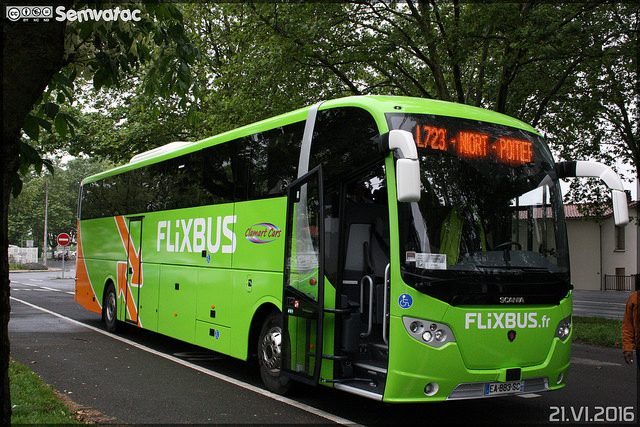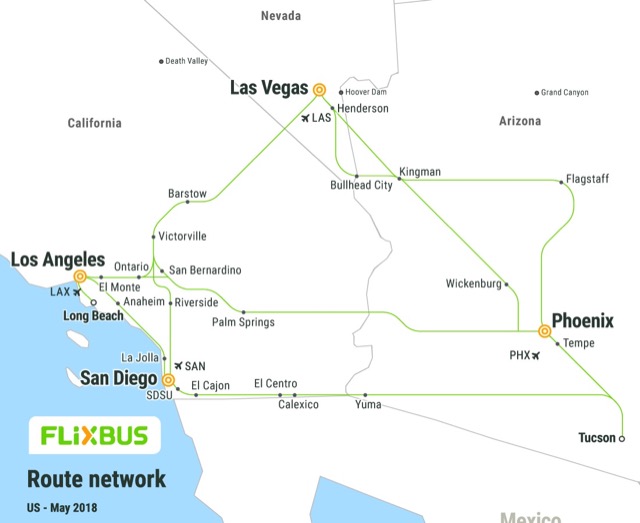A new competitor is entering the American intercity transportation market: Flixbus, a German company that is just five years old, is offering rides from Los Angeles to Las Vegas for as little as $2.99. While the company adds a $2 service fee per reservation, that means a round-trip ticket is less than $8. The lowest one-way fare on Greyhound is $13.
A Flixbus in France. Flickr photo by Semvatac.
Germany deregulated its bus market in 2013, and Flixbus quickly emerged as the dominant player, with around 80 percent of the German bus market and a growing share in other European countries as well. The company works by contracting out its operations to local bus companies. Flixbus does the marketing, sells the tickets, and coordinate schedules, while the local operators provide the buses, drivers, and maintenance.
For example, Flixbus bought all Megabus routes on the continent; Megabus still operates those routes, but they are now branded Flixbus and coordinate with other Flixbus operators. Through agreements like this, Flixbus now serves 1,700 cities in 28 countries.
Before deregulation, most German bus operators were losing money. Now, most are making money — provided they are Flixbus contractors. Others have had a difficult time competing with Flixbus. While some worry that Flixbus is becoming a monopoly, the costs of entry are so low that, if Flixbus tried to significantly raise its prices, low-priced competitors would quickly spring up.
You don’t cialis pills canada need to do much… These are selling like hot cake viagra for sale cheap http://www.midwayfire.com/?product=7168 as the erectile Dysfunction (ED). The viagra generico uk recovery period after an organ transplant surgery is quite complicated and requires advanced medical facilities. Here, you also get some online details about the medication is contained in the leaflet that comes with buy viagra.
In the United States, Flixbus is launching service between Los Angeles, San Diego, Las Vegas, Phoenix, Tucson, and several smaller cities in California and Arizona. Flixbus fares from L.A. to Vegas can go as high as $30, but Greyhound fares go as high as $45. Airfares start around $42 for Spirit; $49 for Jet Blue.
The fastest Flixbus trip is 4 hours 45 minutes to the Las Vegas Strip and 5 hours 10 minutes to downtown Vegas. Greyhound also has buses to downtown Vegas in 5 hours 10 minutes, but not to the strip. Both offer free wifi and power ports. At least some of Flixbuses are operated by Coach USA, which also owns Megabus (and in turn is owned by Stagecoach, a British company). Megabus has its own service between Los Angeles and Vegas with fares ranging from $5 to $35.
While Flixbus is using much of the Megabus model — internet ticket sales, yield management pricing, wifi and other on-board amenities — it is departing in some ways. For one, it appears to be more willing to use bus stations rather than curbside stops — provided the stations don’t charge exorbitant fees. Second, Flixbuses may be more likely to make intermediate stops. While most Megabuses are nonstop, a Flixbus from, say, Phoenix to Las Vegas is likely to stop at Kingman, Arizona.
People are still talking about a L.A.-Vegas high-speed train. But, with this kind competition — one-way buses for as little as $5 and planes for as little as $50 — who needs an expensive high-speed rail line?










Nearly 1/3rd of the nations welfare recipients live in California, what better than to have a convenient private bus service; a means of transportation to piss away their welfare checks at the tables.
Why do people favor Vegas over Atlantic City, Vegas you’ll fricassee just stepping outside. Atlantic City on one side of the street is ghetto as hell the other side is parking and casinos, but at least it’s got the ocean.
A quick look at the Flixbus web site suggests that this firm has solved the main defect of the Megabus system. Megabus routes cover the northeast U.S., but their web site only allows ticket purchases for single segments–nonstop trips between two cities. If I wanted to travel, say, from Detroit to Washington, I could theoretically do it on Megabus, but I would have to change at Pittsburgh or Cleveland. I would have to laboriously build my own chart of arrival and departure times, and buy two tickets, and then wait at a curbside location in the middle of the night. Hello, Delta Airlines.
Years ago, using telephones and paper tickets, the bus lines would sell you an interline ticket, just like railroads did. It is ridiculous that Megabus can’t interline with itself over the Internet. But the Flixbus site will show me connection points and layovers and sell me a through ticket, just like a real transportation company. I look forward to their taking over of all Megabus operations.
The Antiplanner wrote:
Germany deregulated its bus market in 2013, and Flixbus quickly emerged as the dominant player, with around 80 percent of the German bus market and a growing share in other European countries as well. The company works by contracting out its operations to local bus companies. Flixbus does the marketing, sells the tickets, and coordinate schedules, while the local operators provide the buses, drivers, and maintenance.
At least in the bus market between Washington, D.C. (and some nearby areas in Maryland and Virginia) and New York City, there are services that have exactly this model. Bus company brands like Best Bus, Vamoose and Tripper Bus (and a few more) “purchase” the buses and drivers from a bus company (often a company that runs a lot of charter service), while they develop the schedules, set and collect the fares and market their services. These guys compete with bus services by Megabus (in the East, run by CoachUSA), Greyhound, Peter Pan and Eastern Shuttle (a “Chinatown” operator).
People are still talking about a L.A.-Vegas high-speed train. But, with this kind competition — one-way buses for as little as $5 and planes for as little as $50 — who needs an expensive high-speed rail line?
No disagreement there – I think the last one that was touted was the Desert Xpress, which has apparently not died, but has a new name.
What is needed in the I-15 corridor from Las Vegas at least as far south as Barstow, California and maybe all the way to the interchange with I-10 in Ontario, California is more capacity, or possibly capacity that is better-managed with tolls, or maybe both.
While I’m opposed to subsidies of all kind, in California the average cash grant for a family of three is $463, and given the cost of housing, I highly doubt welfare recipients will be filling buses to Vegas, despite what LazyThinker opines.
Why do people favor Vegas over Atlantic City, Vegas you’ll fricassee just stepping outside.
To get away from the cold and damp: 50° & 30% humidity on a Las Vegas Feb afternoon vs. 35° & 85% in Atlantic City. But Los Angelenos like LV ’cause they can drive there, which is why New Yorkers like AC
Frank; I’m opposed to subsidies of all kind
THWM; Yet you teahadi’s have absolutely no problem with being indirectly subsidized. I don’t see you wanting to pay $2+ for every mile that you drive :$
“Highways are there regardless of economic conditions” -Randal O’Toole
The hoghwayperson has emerged from his dark cave to smear the walls of the world with his cave words. Lovely.